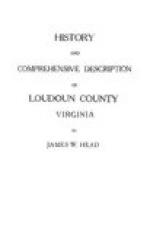When the State of Virginia called a convention for the revision of her constitution, Mr. Monroe consented to become a member. He took an active interest in the affairs of his own neighborhood, discharging the duties of a local magistrate.
Mrs. Monroe died at “Oak Hill” on September 23d, 1830, and after her departure the old man found his lonely farm life insupportable. He had previously visited much with his daughters, and he now went to live with Mrs. Gouverneur, in New York. He wrote to Mr. Madison, April 11, 1831:
* * * * *
“It is very distressing to me to sell my property in Loudoun, for besides parting with all I have in the State, I indulged a hope, if I could retain it, that I might be able occasionally to visit it, and meet my friends, or many of them, there. But ill health and advanced years prescribe a course which we must pursue....”
GENERAL LAFAYETTE’S VISIT.[27]
The greatest social event in the history of Leesburg was the visit of General Lafayette, August 9, 1825. The great Frenchman, accompanied by President John Quincy Adams, had visited ex-President Monroe at “Oak Hill,” from which place the august procession, headed by two troops of cavalry, made the eleven mile journey to Leesburg. Lafayette, the President, the ex-President and the chairman of the Town Council, rode in the first carriage, drawn by four white horses. On reaching Leesburg, they were greeted by six companies of militia, among them a few old soldiers of the Revolution. At the firing of the national salute, Lafayette descended from his carriage and shook hands with those veterans and heroes.
[Footnote 27: This account of General Lafayette’s visit, save for a few minor alterations and one or two supplementary facts, is from the pen of Mrs. A. H. Throckmorton, of this County, having formed part of an historical sketch of Leesburg contributed by her to the old Richmond Times, July 19, 1902.]
Standing on his front porch, Dr. McCabe, the town’s Mayor, delivered an address of welcome to which Lafayette responded. Across the street at Osborne’s Hotel[28] a reception was tendered him, after which the distinguished visitor was driven through the principal streets of the town. On reaching the court-house square, then, as now, a large inclosure shaded by giant trees, Lafayette, on alighting from the coach, kissed a tiny maiden upheld in the arms of her negro nurse. The little girl was Mrs. Wildman, who after reaching a venerable age departed this life in the summer of 1901.
[Footnote 28: A fine stone mansion, still standing, and the residence of the late Colonel John H. Alexander, during his lifetime one of the foremost lawyers of the State.]
Lafayette passed up an avenue formed on the right by boys and girls and the young ladies of Leesburg Female Academy, and on the left by the youths of the Leesburg Institute. The former wore white, with blue sashes, and their heads were tastefully adorned with evergreens. They held sprigs of laurel with which they strewed the great guest’s pathway. The lads wore red sashes and white and black cockades.




